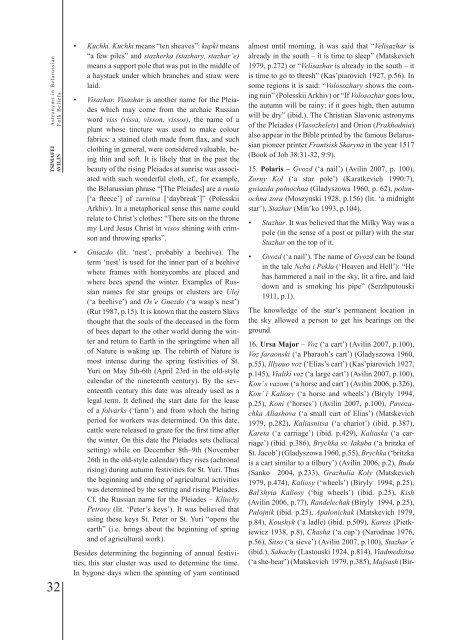BALTICA10
BALTICA10
BALTICA10
You also want an ePaper? Increase the reach of your titles
YUMPU automatically turns print PDFs into web optimized ePapers that Google loves.
Astronyms in Belarussian<br />
Folk Beliefs<br />
TSIMAFEI<br />
AVILIN<br />
32<br />
• Kuchki. Kuchki means “ten sheaves”: kupki means<br />
“a few piles” and stazherka (stazhary, stazhar’e)<br />
means a support pole that was put in the middle of<br />
a haystack under which branches and straw were<br />
laid.<br />
• Visazhar. Visazhar is another name for the Pleiades<br />
which may come from the archaic Russian<br />
word viss (vissa, visson, vissos), the name of a<br />
plant whose tincture was used to make colour<br />
fabrics: a stained cloth made from flax, and such<br />
clothing in general, were considered valuable, being<br />
thin and soft. It is likely that in the past the<br />
beauty of the rising Pleiades at sunrise was associated<br />
with such wonderful cloth, cf., for example,<br />
the Belarussian phrase “[The Pleiades] are a runia<br />
[‘a fleece’] of zarnitsa [‘daybreak’]” (Polesskii<br />
Arkhiv). In a metaphorical sense this name could<br />
relate to Christ’s clothes: “There sits on the throne<br />
my Lord Jesus Christ in visos shining with crimson<br />
and throwing sparks”.<br />
• Gniazdo (lit. ‘nest’, probably a beehive). The<br />
term ‘nest’ is used for the inner part of a beehive<br />
where frames with honeycombs are placed and<br />
where bees spend the winter. Examples of Russian<br />
names for star groups or clusters are Ulej<br />
(‘a beehive’) and Os’e Gnezdo (‘a wasp’s nest’)<br />
(Rut 1987, p.15). It is known that the eastern Slavs<br />
thought that the souls of the deceased in the form<br />
of bees depart to the other world during the winter<br />
and return to Earth in the springtime when all<br />
of Nature is waking up. The rebirth of Nature is<br />
most intense during the spring festivities of St.<br />
Yuri on May 5th-6th (April 23rd in the old-style<br />
calendar of the nineteenth century). By the seventeenth<br />
century this date was already used as a<br />
legal term. It defined the start date for the lease<br />
of a folvarks (‘farm’) and from which the hiring<br />
period for workers was determined. On this date,<br />
cattle were released to graze for the first time after<br />
the winter. On this date the Pleiades sets (heliacal<br />
setting) while on December 8th–9th (November<br />
26th in the old-style calendar) they rises (achronal<br />
rising) during autumn festivities for St. Yuri. Thus<br />
the beginning and ending of agricultural activities<br />
was determined by the setting and rising Pleiades.<br />
Cf. the Russian name for the Pleiades – Kliuchy<br />
Petrovy (lit. ‘Peter’s keys’). It was believed that<br />
using these keys St. Peter or St. Yuri “opens the<br />
earth” (i.e. brings about the beginning of spring<br />
and of agricultural work).<br />
Besides determining the beginning of annual festivities,<br />
this star cluster was used to determine the time.<br />
In bygone days when the spinning of yarn continued<br />
almost until morning, it was said that “Velisazhar is<br />
already in the south – it is time to sleep” (Matskevich<br />
1979, p.272) or “Velisazhar is already in the south – it<br />
is time to go to thresh” (Kаs’piarоvіch 1927, p.56). In<br />
some regions it is said: “Volosozhary shows the coming<br />
rain” (Polesskii Arkhiv) or “If Volosozhar goes low,<br />
the autumn will be rainy; if it goes high, then autumn<br />
will be dry” (ibid.). The Christian Slavonic astronyms<br />
of the Pleiades (Vlasozhelets) and Orion (Prakhodnia)<br />
also appear in the Bible printed by the famous Belarussian<br />
pioneer printer Frantsisk Skaryna in the year 1517<br />
(Book of Job 38:31-32, 9:9).<br />
15. Polaris – Gvozd (‘a nail’) (Avilin 2007, p. 100),<br />
Zorny Kol (‘a star pole’) (Kаrаtkеvіch 1990:7),<br />
gwiazda polnochna (Gladyszowa 1960, p. 62), polunochna<br />
zora (Moszynski 1928, p.156) (lit. ‘a midnight<br />
star’), Stazhar (Mіn’kо 1993, p.104).<br />
• Stazhar. It was believed that the Milky Way was a<br />
pole (in the sense of a post or pillar) with the star<br />
Stazhar on the top of it.<br />
• Gvozd (‘a nail’). The name of Gvozd can be found<br />
in the tale Neba i Pekla (‘Heaven and Hell’): “He<br />
has hammered a nail in the sky, lit a fire, and laid<br />
down and is smoking his pipe” (Sеrzhputоuskі<br />
1911, p.1).<br />
The knowledge of the star’s permanent location in<br />
the sky allowed a person to get his bearings on the<br />
ground.<br />
16. Ursa Major – Voz (‘a cart’) (Avilin 2007, p.100),<br />
Voz faraonski (‘a Pharaoh’s cart’) (Gladyszowa 1960,<br />
p.55), Illyouo voz (‘Elias’s cart’) (Kаs’piarоvіch 1927,<br />
p.145), Vialiki voz (‘a large cart’) (Avilin 2007, p.100),<br />
Kon’ s vazom (‘a horse and cart’) (Avilin 2006, p.326),<br />
Kon’ i Kaliosy (‘a horse and wheels’) (Biryly 1994,<br />
p.25), Koni (‘horses’) (Avilin 2007, p.100), Pavozachka<br />
Aliashova (‘a small cart of Elias’) (Matskevich<br />
1979, p.282), Kaliasnitsa (‘a chariot’) (ibid. p.387),<br />
Kareta (‘a carriage’) (ibid. p.429), Kaliaska (‘a carriage’)<br />
(ibid. p.386), Brychka sv. Iakuba (‘a britzka of<br />
St. Jacob’) (Gladyszowa 1960, p.55), Brychka (‘britzka<br />
is a cart similar to a tilbury’) (Avilin 2006, p.2), Buda<br />
(Sanko 2004, p.233), Grazhulia Koly (Matskevich<br />
1979, p.474), Kaliosy (‘wheels’) (Biryly 1994, p.25),<br />
Bal’shyia Kaliosy (‘big wheels’) (ibid. p.25), Kish<br />
(Avilin 2006, p.77), Randelechak (Biryly 1994, p.25),<br />
Palojnik (ibid. p.25), Apalonichak (Matskevich 1979,<br />
p.84), Koushyk (‘a ladle) (ibid. p.509), Karets (Pietkiewicz<br />
1938, p.8), Chasha (‘a cup’) (Nаrоdnае 1976,<br />
p.56), Sitso (‘a sieve’) (Avilin 2007, p.100), Stazhar’e<br />
(ibid.), Sahachy (Lаstоuskі 1924, p.814), Viadmedzitsa<br />
(‘a she-bear’) (Matskevich 1979, p.385), Majsash (Bir-
















